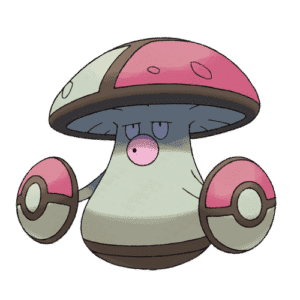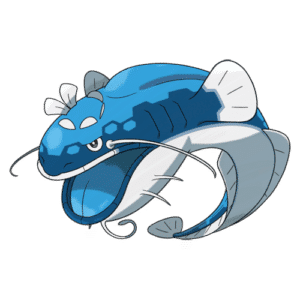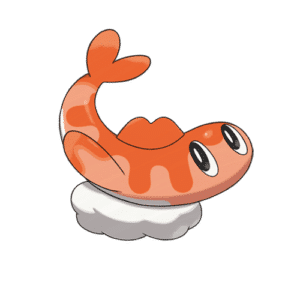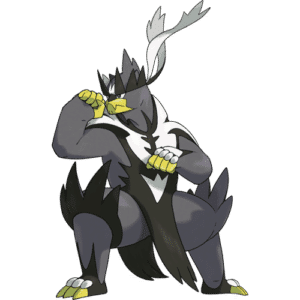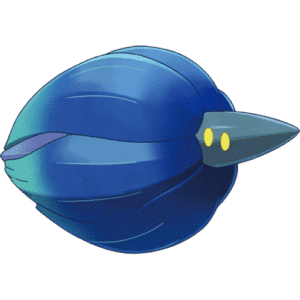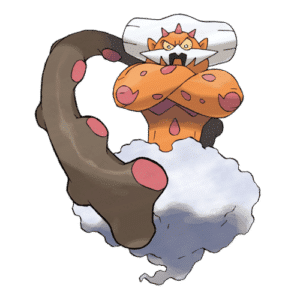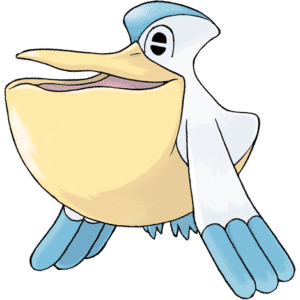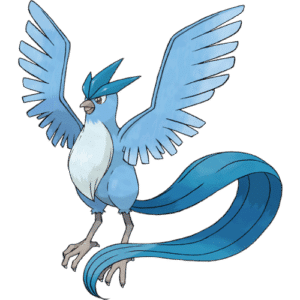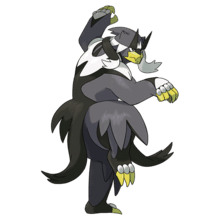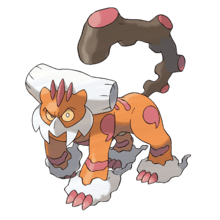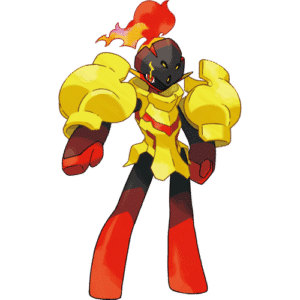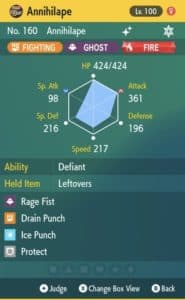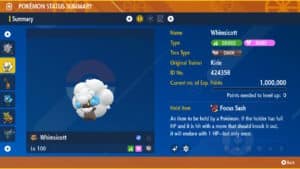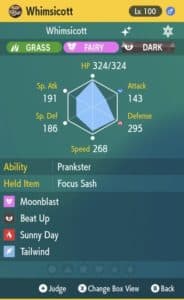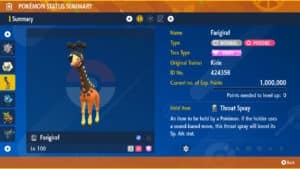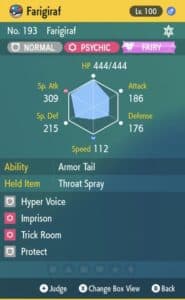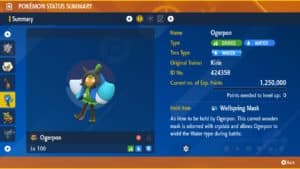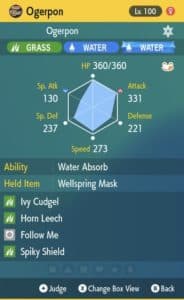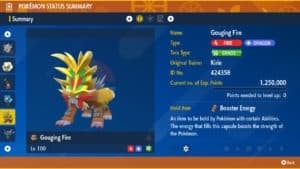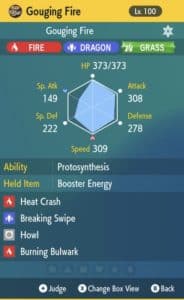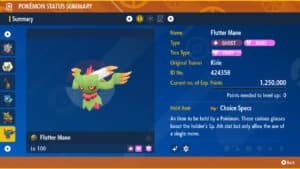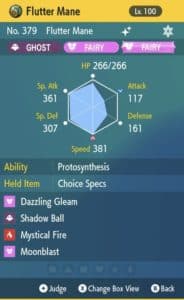Hey Trainers!
It’s been quite a while since I’ve written an article, so I figured, why not get back to it with another over complicated VGC article? Toward the end of 2023 I wrote an analysis of my experience competing on Scarlet and Violet’s in-game competitive Double Battle ladder. Since then, we have seen the introduction of a new DLC: the Indigo Disc!
Among many exciting new adventures to be had at the Blueberry Academy, the DLC introduced a plethora of new Pokémon that have made some exciting new additions to the VGC scene. As with the last article, we’ll go over the exciting new faces, some returning favorites, and some former stars that have fallen from grace. However, we will have a new addition, which will be the Pokémon that are faring much better now than they were in Regulation E. To wrap it up, I’ll go over the team I’ve been using to decent levels of success. Let’s dive in!
A Note About Terapagos
Before we dive into the list, we have to talk about the mascot of the Indigo Disc DLC. Just like with the Teal Mask, the new DLC and its story revolves heavily around a specific Legendary Pokémon: Terapagos!
Terapagos is a Normal type Pokémon with a lot of interesting features, both in its design and its mechanics, which could warrant its own article in the future. However, Terapagos is not legal in Regulation F VGC. This is due to its classification as a Restricted Legendary Pokémon.
Certain Legendary Pokémon have been deemed too powerful for general usage. These Legendaries, such as Groudon, Kyogre, Zacian, Koraidon, and many more are among the strongest Pokémon in the game. They are only allowed in rulesets known as Restricted Formats.
Not all Legendary Pokémon fall under this category. The Kanto Birds, Johto Beasts, and Unova Swords of Justice are among the list of Legendary Pokémon that are able to be used so long as they are present in the Pokédex, and there is no limit to how many of these you can use on your team.
As Regulation F is not a Restricted Format, Terapagos is unfortunately now allowed to be used. However, The Pokémon Company recently announced the next ruleset, Regulation G, which allows for each team to use 1 Restricted Legendary. I will likely cover that in its own article once it comes out, but from the bit of the format I have played (on Showdown), Terapagos is very powerful. However, that explanation is best left for Regulation G.
A New Tera Type
The last thing to note is the introduction of a new “type”: the Stellar type! This feature had been teased for months leading up to the Indigo Disc, and it was finally revealed through the events of the DLC’s story.
The Stellar Type allows the Pokémon to gain the power of all 18 of the base types when Terastalizing. When a Pokémon Terastalizes to Stellar, the Pokémon receives the Terastalized buff to the first of each attack it uses of each unique type. I know this seems a bit confusing, so I’ll try to explain with an example. Say I have a Mewtwo with the Stellar Tera Type and the moves Psystrike, Ice Beam, Thunderbolt, and Psychic. After Terastalizing, the next time Mewtwo uses either Ice Beam or Thunderbolt, it will receive the 1.5x damage multiplier for same type attack bonus (STAB). If it uses Psystrike, it will gain a 2x boost from its normal STAB bonus plus the Tera bonus. However, if it uses the move Psychic, it will not receive the Tera boost, as you have already used a Psychic type move. It also will not gain the bonus on consecutive uses of Psystrike, Thunderbolt, or Ice Beam.
It’s important to note that defensively, the Stellar Tera Pokémon will keep its defensive typing and properties.
The Stellar Tera Type is designed as a purely offensive tool. Its introduction has had mixed reception, with the majority of the VGC community agreeing that it isn’t that strong. There are a few cases where it can be an interesting addition to the team, but part of Terastalization’s strength is the combination of the defensive benefits alongside the offensive ones. Throughout this article, I will list the Pokémon that can potentially benefit from Tera Stellar, but know that they will be few and far between.
With all of that out of the way, let’s take a look at some of the powerful new faces of Regulation F!
New Faces
Incineroar
Type: Fire / Dark
Ability: Blaze, Intimidate
Common Items: Sitrus Berry, Safety Goggles, Assault Vest
Common Moves: Fake Out, Flare Blitz, Knock Off, Parting Shot, U-Turn, Snarl, Will-O-Wisp
Common Tera Type: Grass, Dragon
Let’s get this out of the way: the king of VGC has returned. For those of you who may be unfamiliar, Incineroar is widely agreed upon to be the strongest Pokémon in the game. However, it isn’t due to its overwhelming offensive presence like many Legendary Pokémon are known for, but rather as its role as a catch-all support Pokémon. Pokémon World Champion Wolfe Glick has an entire video dedicated to explaining Incineroar’s strength, which you can watch here. I will do my best to sum it up here.
Incineroar was largely useless until it got access to its Hidden Ability Intimidate. Intimidate is one of the best Abilities in VGC, as it drops both opponents to 2/3 of their Attack just by switching in. This pairs well with Incineroar’s access to Fake Out, which can prevent opponents from moving but can only be used on the Pokémon’s first turn in battle. What’s more, Incineroar has access to two different moves, Parting Shot and U-Turn, that can switch it out in order to be switched back in later. It is extremely bulky, but it has a high base Attack stat that can deal solid damage without any investment, especially when using powerful moves like Flare Blitz or even utility moves such as Knock Off to remove an opponent’s item.
While there are more and more tools being introduced to counter Incineroar, it is still undoubtedly one of the strongest Pokémon in the game and is a worthy addition to this list.
Archaludon
Type: Steel / Dragon
Ability: Stamina, Sturdy, Stalwart
Common Items: Assault Vest, Power Herb, Leftovers
Common Moves: Electro Shot, Flash Cannon, Draco Meteor, Body Press
Common Tera Type: Fighting, , Stellar
Archaludon was my personal most anticipated Pokémon for the DLC. I don’t know what it was that caught my attention, but it was the first Pokémon that I tried to build a team around.
Archaludon has a new signature move called Electro Shot, a powerful Electric type attack. It is very similar to a Rock type move called Meteor Beam (which we will talk about later). Both of these moves operate like Solar Beam, where the user needs to charge up the first turn, then attacks the second. However, both Electro Shot and Meteor Beam have the added benefit of boosting the user’s Special Attack stat by one stage when charging. Electro Shot is even more powerful because of a niche mechanic where if it is used in Rain, Archaludon is able to fire off Electro Shot immediately! This provides nice coverage specifically against Water types that Archaludon might struggle to hit otherwise.
There are a variety of sets that have seen play for Archaludon. My personal favorite is with Stamina as its Ability, which boosts its Defense stat every time it gets hit. This pairs very nicely with the Fighting type move Body Press, which uses the Defense stat to calculate damage instead of the Attack stat. This allows Archaludon to hit opposing Steel types that would otherwise wall it. Paired with the Assault Vest item, this set makes Archaludon extremely difficult to remove. However, this build needs to be paired with a Rain setter like Pelipper or Tornadus. Recently a Power Herb set with Sturdy has seen success, partially because it doesn’t rely on Rain and partially because it allows Archaludon to run Protect.
Regardless of which set you run, this funny looking bridge Pokémon is definitely a threat to watch out for in Regulation F.
Gouging Fire
Type: Fire / Dragon
Ability: Protosynthesis
Common Items: Booster Energy, Clear Amulet
Common Moves: Heat Crash, Breaking Swipe, Howl, Burning Bulwark
Common Tera Type: Grass, Fairy
Prior to the release of either DLC, two Paradox Pokémon were released through a limited time event. These were Walking Wake, the ancient form of Suicune, and Iron Leaves, the future form of Virizion. The release of the Indigo Disc DLC brought with it four new Paradox Pokémon that were ancient/future forms of the rest of the respective trios, with Gouging Fire being the ancient form of Entei.
Gouging Fire received an interesting new signature move called Burning Bulwark. This move functions similarly to but not quite the same as the VGC staple Protect. However, Burning Bulwark works more similarly to Aegislash’s signature move King’s Shield. When used, it will protect Gouging Fire from any attacking moves, but any status moves, such as Spore or Parting Shot, will still connect. On the plus side, any moves that make physical contact with Burning Bulwark will result in the attacker being Burned. It is not strictly better than Protect, rather a sidegrade that is better in some situations and worse in others.
At first players thought that Gouging Fire would operate as a Dragon Dance sweeper, using the Clear Amulet to block any stat drops. While this does work to a certain extent, it lacks a solid Dragon type offensive move to fully utilize this set. It functions better as a fast, supportive Pokémon that can also dish out solid damage on its own. It can use Howl to raise its partner’s Attack stat as well as its own, and with a Booster Energy it can to boost its Speed it is essentially the same as a Dragon Dance. Since it lacks a strong Dragon type offensive move, Breaking Swipe serves as nice utility to lower both opponents’ Attack stats, and Heat Crash is its best offensive option. Either option for Tera type serves to mitigate some of its most potent weaknesses.
While Gouging Fire didn’t play the role that we might have expected, it has solid presence on the field and can easily run away with the game in the right situation.
Raging Bolt
Type: Electric / Dragon
Ability: Protosynthesis
Common Items: Booster Energy, Assault Vest, Leftovers, Life Orb, Magnet
Common Moves: Thunderclap, Thunderbolt, Draco Meteor, Calm Mind, Snarl, Electroweb
Common Tera Type: Electric, Fairy
Similarly to Gouging Fire, Raging Bolt is a member of the ancient version of the Johto Beasts trio, being the ancient form of Raikou. While this goofy looking giraffe was clowned on upon its reveal, Raging Bolt is anything but a joke.
Raging Bolt’s signature move is called Thunderclap. It is an Electric type Special move that operates similarly to Sucker Punch, attacking first if the opponent uses an attacking move. This is an amazing move on Raging Bolt, as its stats are more geared towards bulk and offense rather than speed. It has a plethora of other great moves to round out its moveset, with Thunderbolt and Draco Meteor being its most consistent options, Calm Mind for a setup build, and even great supporting moves like Snarl and Electroweb to help control the battle while still dishing out damage.
Raging Bolt has been a potent threat for the entirety of Regulation F. It is currently the second most used Pokémon in the format behind only Flutter Mane. It is more widely used than even Incineroar! As we have been playing in this format for several months, there have been several effective sets that have seen significant play. There have been more defensive sets that utilize an Assault Vest or Leftovers and Calm Mind that use Tera Fairy to mitigate Raging Bolt’s weaknesses, or more offensive ones that use Booster Energy or even Magnet combined with Tera Electric that can pick up KO’s that shouldn’t seem possible. Each of these sets are viable in their own way, and you never know exactly which one you’re going to face on the ladder.
One thing is certain: if you see the giraffe on the other side of the battlefield, be prepared for a fight!
Iron Crown
Type: Steel / Psychic
Ability: Quark Drive
Common Items: Booster Energy, Assault Vest, Life Orb
Common Moves: Expanding Force, Tachyon Cutter, Calm Mind, Focus Blast
Common Tera Type: Psychic, Water
Iron Crown is the first (and spoiler alert: only) future Paradox Pokémon in this section. It is the future form of Cobalion, and it is a potent Special Attacker.
Iron Crown’s signature move is called Tachyon Cutter. It is a Steel type move that always hits twice with 50 base power on each hit, totaling to 100 base power with each use, and can never miss. While this move isn’t insane by any means, it is a solid, no drawback move that Iron Crown will basically always be running.
Iron Crown fills a niche in the meta due to gaining access to one specific move, the powerful Psychic type attack Expanding Force. To sum it up, Expanding Force doubles in power and hits both opponents when the Psychic Terrain effect is active. This extremely powerful move was introduced in Sword and Shield, and the strategy around it became known as Psyspam. However, Game Freak recognized the power of this strategy, so going into Scarlet and Violet only one Pokémon in the game learned this attack, that being Armarouge. While Armarouge is not weak by any means, Iron Crown has more tools that can help it take full advantage of the Psyspam strategy.
Iron Crown will usually run the Booster Energy item to boost its Speed. On top of the aforementioned boosts that Expanding Force gets on Psychic Terrain, it also receives the same boost to damage as all other Psychic attacks get, so it isn’t lacking in damage output. On top of this, the only Psychic Terrain setter in the game is Indeedee, so it is literally always paired with Iron Crown, and it often runs Helping Hand to further boost the damage output. Booster Energy gives Iron Crown the flexibility to either set up with Calm Mind or to switch to Tachyon Cutter or coverage move Focus Blast to hit any Psychic resists, but Assault Vest is another good option to provide some more defense, as you are often only clicking Expanding Force anyway.
Iron Crown has taken an already powerful strategy and boosted it to new heights. Only time will tell how powerful this combination continues to be.
Whimsicott
Type: Grass / Fairy
Ability: Prankster, Infiltrator, Chlorophyll
Common Items: Focus Sash, Mental Herb
Common Moves: Tailwind, Moonblast, Sunny Day, Stun Spore, Helping Hand
Common Tera Type: Dark
For those of you that are unfamiliar with VGC, Whimsicott may seem like an odd pick for this list. It isn’t that strong, and on top of that is pretty frail. However, it has a specific combination of attributes that make it an amazing addition to almost any team. The combination of the ability Prankster and the move Tailwind has always been a powerful asset, but it was made even better in Sword and Shield. Prior to Generation 8, speed tiers were determined at the beginning of each round, and any modifiers to speed made during the turn, such as Tailwind, would be calculated starting on the next turn. Starting in Galar, however, speed changes became dynamic, meaning that if Tailwind was used by one Pokémon before its partner moved, then that partner would immediately gain the doubled speed that Tailwind provides. With Prankster, Tailwind becomes a priority move, meaning it will almost always be used first. This combination is so powerful that it allowed even Murkrow (no, not Honchkrow!) to see some competitive usage at the start of Scarlet and Violet’s competitive scene.
Since Regulation E, Tornadus has been the premiere Prankster Tailwind setter of the format. There are other viable options, but Tornadus has largely dominated the VGC scene. However, Whimsicott fills the same role in a different yet equally powerful way. While its immunity to Dragon attacks is worth noting, its immunity to Spore is even more valuable. Additionally, it gets some utility moves that other Prankster Pokémon don’t. I know this is pretty vague, but there is one powerful strategy that Whimsicott can be especially effective with, but I don’t want to spoil it just yet (see my team building section below for more details!).
You are almost never going to Terastalize Whimsicott, but Tera Dark makes it immune to opposing Prankster moves, shutting down Tornadus or Thundurus’s Taunt that would otherwise cripple it. The same can be achieved with the Mental Herb item, although Focus Sash is much more common.
While it definitely will never surpass Tornadus in viability, Whimsicott is still a force to be reckoned with!
Smeargle
Type: Normal
Ability: Own Tempo, Technician, Moody
Common Items: Focus Sash
Common Moves: Fake Out, Follow Me, Spore
Common Tera Type: Ghost
This is another pick that may seem surprising if you’re unfamiliar with VGC. However, Smeargle has left one of the biggest impacts of any Pokémon on the competitive scene thanks to its ability to learn any move in the game. In Generation 6 VGC, Smeargle was present on almost every team, spamming Darkrai’s signature move Dark Void to put both opponents to Sleep without fail. Smeargle was able to hang with powerful Megas and Legendaries thanks to access to this one move alone.
While this has thankfully been nerfed, Smeargle is still able to learn every move in the game, allowing you to tailor it to fill whatever role your team needs. Common moves include Fake Out, which is always valuable on a team, Follow Me to protect its teammates, and Spore to relive its glory days of Gen 6 VGC. Smeargle is one Pokémon that is always scary to see on the team preview screen because it can literally do anything.
Entei
Type: Fire
Ability: Pressure, Inner Focus
Common Items: Assault Vest, Choice Band
Common Moves: Extreme Speed, Sacred Fire, Stomping Tantrum, Snarl
Common Tera Type: Normal
Entei may not be as flashy as its Paradox Pokémon counterpart, but it is just as powerful, if not more. Entei has always been a decent Pokémon, but its full potential was unlocked when it gained access to its Hidden Ability Inner Focus in Generation 7. Inner Focus is an Ability that makes that Pokémon immune to flinching, which is already great at countering the various different Fake Out Pokémon. However, in Generation 7, Inner Focus was also buffed to also prevent the Ability Intimidate from working.
Fake Out and Intimidate are two of the most potent threats in all of VGC, so having a single Ability that prevents them both is bound to see play. This is the combination that has made Dragonite a mainstay of VGC throughout Scarlet and Violet. However, Dragonite lacked strong moves for its regular STAB types, resorting to Outrage or Dragon Claw for Dragon moves and Wing Attack or Aerial Ace for . It relied heavily on Terastalizing to Normal and spamming Extreme Speed with a Choice Band item.
While this strategy does still work to great effect with Entei, it is not the only viable option. Entei can serve as a bulky attacker with an Assault Vest instead, able to switch between Extreme Speed and other moves like Scared Fire and Stomping Tantrum. Tera Normal is still a good option to mitigate Entei’s weaknesses and to boost the power of Extreme Speed, but it is not forced to Terastalize in order to be viable.
Comparing Entei and Dragonite is interesting, as one is not strictly better than the other. Entei is faster than Dragonite, but Dragonite hits a bit harder. However, Entei’s flexibility means that it is seeing more play as of now, and Trainers should be ready to face it.
Oof, that was once again a lot of information all at once, but y’all are probably used to it by now. Now let’s take a look at some of the returning favorites!
Returning Favorites
Flutter Mane
Flutter Mane is still as dominant as ever. Despite all of the powerful additions that we have seen over the various regulations, it is still the most used Pokémon in the format. It can be slotted onto pretty much any team to high levels of success, and while its Ability boosts it to staggering heights, it doesn’t even need it to succeed. Flutter Mane is here to stay.
Chien-Pao
Chien-Pao is still extremely viable thanks to its Sword of Ruin Ability, which passively reduces the Defense of all Pokémon on the field. It pairs extremely well with any physical attacker in the format, such as staples from previous formats like Ogerpon as well as newer faces like Entei.
While the previously viable set of Tera Ghost, Focus Sash, and its standard moves of Icicle Crash, Sucker Punch, Sacred Sword, and Protect work, people have also been running Clear Amulet with Tera Stellar to varying levels of success. However, it still functions largely the same and is just as threatening.
Chi-Yu
Similarly to Chien-Pao, Chi-Yu sees similar viability in Regulation F thanks to its Beads of Ruin Ability that lowers the Special Defense of all Pokémon on the field. It largely plays the same as it has in the past, and is just as threatening as ever.
Ogerpon
The mascot of the Teal Mask DLC is still a potent threat in Regulation F. Of its four forms, the Wellspring Water mask is the most used, followed by Hearthflame Fire, then Teal Grass, then Cornerstone Rock. Regardless of the ranking, all four forms are extremely powerful and can play varying offensive or supporting roles on the team, made even more powerful by Terastalizing. If you’re playing VGC, you should definitely be ready to tank an Ivy Cudgel or two.
Tornadus
As mentioned previously, Tornadus is still the premiere Prankster Tailwind setter. Its signature move Bleakwind Storm is still extremely powerful, meaning that Tornadus still has presence on the field despite being a support Pokémon. It has numerous support options, from weather setting to Taunt support and more. You cannot go wrong with this genie on your team!
Rillaboom
While Incineroar has taken the role as the primary Fake Out user, Rillaboom is still a potent threat. It is a bulky attacker made even bulkier by the Grassy Terrain it sets through its Ability, as well as by the Assault Vest it usually holds. It has a strong priority option in Grassy Glide, as well as high damage output through Wood Hammer. Despite Incineroar’s dominance, many players are choosing to use both powerful Fake Out options to provide a near endless wave of flinch support to their team. The Drummer Pokémon is just as threatening as ever!
Farigaraf
Farigaraf is a Pokémon that I failed to add to the list in my article covering Regulation E, but make no mistake, this long awaited evolution for Girafarig is surprisingly powerful. Its signature Ability called Armor Tail prevents the use of any priority move. In addition to blocking moves like Extreme Speed, it also blocks Fake Out and any move boosted by Prankster, making Farigaraf an amazing utility Pokémon. It can be used to set Trick Room, but can also dish out respectable damage without much investment. Thanks to the introduction of Raging Bolt and the reintroduction of Incineroar and Entei, as well as the prominance of other priority users such as Rillaboom and Tornadus, Farigaraf has become even more of a staple in VGC than ever before!
Ursaluna

 f
f
This powerful Pokémon hailing from Hisui is still a potent threat, both in its regular and Bloodmoon form. They both serve as powerful Trick Room sweepers, with regular Ursaluna still usually running the Flame Orb and Bloodmoon opting for the Throat Spray. However, Bloodmoon Ursaluna has seen some evolution in its play since its introduction in Regulation E, being able to be used outside of Trick Room as well with proper Speed investment. Regardless of which form you are facing, it is sure to be a fearsome opponent.
Amoongus
Amoongus was never bad, per se, but the overwhelming dominance of Ogerpon in the previous format meant that it was less viable than normal. While Ogerpon is still a problematic matchup, Amoongus does match up positively into Raging Bolt and Flutter Mane, two of the most dominant threats in the format, as well as many other matchups. Additionally, it is never a bad thing to have a 100% accurate Sleep-inducing move on your team, as well as some redirection support in Rage Powder. Regulation F has proven that Amoongus is here to stay!
Dondozo/Tatsugiri
This duo has been terrorizing VGC since the very beginning of Scarlet and Violet. While there have been a variety of different ways Trainers have found to counter them, Dondozo and Tatsugiri have adapted, and their presence in Regulation F is proof of that. There are rarely any cases where you are mad to have a double omni-boost on your team. This duo is still capable of sweeping teams if you aren’t careful.
There are plenty of other powerful Pokémon that are still making waves in Regulation F, but from both my experience as well as the Pikalytics statistics, which represent current usage stats in the format, the Pokémon listed here are the most common and potent threats.
That about wraps it up for this section. Let’s take a look at what’s next!
Taking the Spotlight
Now we will take a look at a section that is a new addition to this article, which is Pokémon that have been legal in the past but have risen significantly in viability in this format. Let’s dive in!
Urshifu (Single Strike)
This may seem a bit surprising, seeing as anyone who is familiar with VGC has probably been terrorized with nightmares of this thing hitting through Protect since Regulation D. However, it’s important to note that Urshifu has two different forms, its Rapid Strikes form which is a Fighting / Water type, and its Single Strike form which is Fighting / dark]. Throughout Scarlet and Violet, Rapid Strikes has been the dominant form in VGC. Its signature move Surging Strikes has historically been able to tear its way through entire teams on its own.
A bit of a spoiler for the “Fallen From Grace” section, but Rapid Strikes Urshifu has seen a massive drop in usage. We’ll get into the exact reasons why later, but this isn’t to say Urshifu is bad. However, Single Strike Urshifu matches up against the Regulation F meta much better across the board. The ability to hit through Protect is extremely valuable, and Single Strike has some tools in its kit that are helping it do extremely well right now. Additionally, while the dual Fighting / Dark type matches up very poorly against Fairy types like Flutter Mane, it does have a notable immunity to Psychic that is rare for Fighting types, making Urshifu do extremely well against Psyspam among other things. Make sure to double check which Urshifu you are going against on turn one so you don’t end up eating a Tera Dark Wicked Blow!
Glimmora
Glimmora has seen usage throughout Scarlet and Violet, but it has never truly been a meta pick. Its Ability, which passively sets Toxic Spikes whenever Glimmora takes a hit, was always a nice bonus, but it definitely fell victim to power creep.
However, Glimmora has gained access to a new move that has single-handedly boosted it to new heights: Meteor Beam. This Rock type Special move functions like Solar Beam, charging the first turn and firing the second, but Meteor Beam has the added benefit of boosting the user’s Special Attack stat by 1 during the charging turn. If given the Power Herb Item, Glimmora can fire off the move immediately, and suddenly you have a fast Special Attacker with solid coverage that can take a chunk out of the opposing team. Additionally, Fake Out is more prevalent than ever. If it is hit by Fake Out, then one layer of Toxic Spikes is already set, so the second hit that it will take to KO Glimmora will spread the second set!
Glimmora is not dominating by any means, but it will not be uncommon to face a few of them on the ladder. It is seeing a lot of play on Dondozo/Tatsugiri teams. It can tear holes in the opposing team and can handle a lot of the problematic matchups for the infamous duo, and the passive Toxic Spikes can help Dondozo outlast any opponents once it does get set up. Now this is how powerful the Champion Geeta’s ace should be!
Landorus (Incarnate)
This was a surprise for sure! Anyone familiar with VGC knows that Landorus’s Therian form as been the dominant form ever since its introduction back in Generation 5. However, times have changed, and Landorus-T is not the premiere Intimidate user, being outclassed by Incineroar among other things. However, saying that Landorus has disappeared from the meta couldn’t be further from the truth.
Landorus’s Incarnate form was never bad, it just couldn’t compare to the value of Intimidate. However, the Incarnate form has an Ability that is arguably just as powerful called Sheer Force. This Ability causes any moves that have secondary effects, such as the Burn chance for Flamethrower or the flinch chance from Headbutt, to lose this secondary effect completely. In exchange, these moves instead gain a 30% boost in damage! This Ability on its own is already extremely powerful, but it also has a very unique interaction with certain Items, removing their secondary effects as well. For some reason, the Life Orb’s recoil damage is negated, but you still get the 30% damage boost. That means that, as long as you’re using moves with a secondary effect, you are getting some pretty insane damage boosts!
Landorus has a plethora of moves that can benefit from the Sheer Force/Life Orb boosts. Most Trainers are running Earth Power and Sludge Bomb, a surprisingly potent offensive combo, combined with Protect and Substitute to make Landorus-I harder to remove while it tears through your team. Its signature move Sandsear Storm is also a decent option instead of Earth Power, trading accuracy for the ability to hit both targets. Landorus Incarnate’s rise just proves the theory that VGC will never truly be rid of this funny looking genie.
Pelipper
Pelipper really hasn’t changed much in the way it plays. It usually runs the standard set of Hurricane, Tailwind, Wide Guard, and Protect. However, its Ability to passively set up Rain makes it an incredible partner for Archaludon. This alone has seen a boost to Pelipper’s usage, paired with other typically powerful Water types that can take advantage of Rain and other Pokémon that benefit from the reduction of Fire type damage. While it will still fall to any powerful Electric attack, Pelipper can do a great job of setting its partners up for success.
Articuno
If you’ve engaged with any VGC content recently, you’ll likely be aware that Articuno, for the first time ever, won a large tournament in the official VGC circuit. There are a plethora of content creators who have covered Articuno’s success and the reasons it has done well.
To try and sum it up, Ice types in general got a buff in Generation 9 thanks to the change from Hail to Snow. Instead of passively damaging all non Ice types each turn, it instead provides a 50% Defense buff to all Ice types instead while still providing all of the passive benefits that Snow enabled for moves and Abilities. Articuno can be made extremely tanky, especially when combined with a partner like Alolan Ninetales who can set up Aurora Veil. This allows it to sit on the field while dishing out 100% accurate Blizzards, and it matches up surprisingly well against the general meta right now.
While it isn’t dominating the meta by any means, it can finally compete on the level of the other two Kanto Birds, and has finally gone from trash to usable.
Fallen From Grace
This list will be much shorter. All three entries on this list are definitely not bad picks and will still likely see some play, but they are far from the usage stats they had in previous formats. With that being said, let’s take a look at this format’s biggest losers.
Urshifu (Rapid Strikes)
As mentioned previously, Urshifu’s Rapid Strikes form has taken a severe hit in usage. Again, this is not to say it is bad. In fact, it is still extremely powerful. However, this thing dominated both Regulation D and E, and it is far more manageable now. Part of this has to do with its incredibly poor matchup against Wellspring Ogerpon, who’s combination of typing, Ability, and access to Follow Me can almost completely wall it. Additionally, it matches up very poorly against some of the new additions such as Raging Bolt and Iron Crown. While it can certainly find a place on some team compositions, it is far from the wave of destruction it was in the past.
Landorus (Therian)
Again, this was spoiled a bit early in the article, but Landorus-T is next up on our list. We pretty much knew this would happen as soon as we saw the starters in the Indigo Disc trailers, indicating the return of Incineroar. While Landorus-T does still maintain a strong matchup against Ogerpon, the Wellspring Mask form, which is currently the most popular, is capable of hitting back just as hard, making it more of a neutral matchup. VGC uses the species clause, meaning you can only have one of each Pokémon species on your team. At present, Trainers would much rather have Landorus’s Incarnate form on their team over the Therian form, which is probably the first time in history that this can be said. I would say rest in peace, but I think that Landorus-T has terrorized VGC enough and can finally be laid to rest.
Armarouge
The final entry in this section is Armarouge, the original face of the Psyspam strategy. Upon Scarlet and Violet’s release, Armarouge was the only Pokémon in the game that could learn Expanding Force, and this allowed it to fill that niche in VGC, at least until the Indigo Disc.
The DLC reintroduced certain moves as TM’s able to be taught to a wider pool of Pokémon, and one of these moves is Expanding Force. While Armarouge is still the only Pokémon that learns the move via level-up learnset, many more powerful Psychic types can now utilize the Psyspam strategy, such as returning Sword and Shield favorite Hatterene, as well as new faces such as Iron Crown.
Armarouge is still useful in certain scenarios, but losing its primary claim to fame definitely hurt its usage stats overall.
Conclusion (kinda)
And with that we’ve covered the majority of the meta for Regulation F. At the time of writing this we are nearing the end of the format, so this article likely won’t be relevant for much longer. However, I still wanted to take this opportunity to talk about the ins and outs of this format.
If you’d like to stick around and see the team I used for this format, then keep scrolling, but if not, then I’ll see you for the chaos that Regulation G is sure to bring!
The Team
I appreciate those of you that have stuck with me this far! This is an opportunity for me to share my own experience, and hopefully some of it is helpful to you! Again, I am by no means an expert at VGC or even team building, but I managed to scrap together another team that works. This season I peaked at top 1500 in the world, so not quite as good as Regulation E but still solid in my opinion! Let’s take a look at the Pokémon that helped me get there!
Annihilape
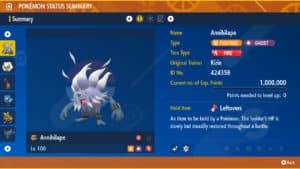
This team was built almost entirely around Annihilape, which was a unique pick to be sure. Most teams this season were built around the Pokémon introduced in the Indigo Disc DLC, and while Annihilape isn’t bad per se, it has definitely stepped out of the spotlight over the past few regulations. However, it is still extremely powerful, and this team proved it can still hang!
Annihilape was an extremely popular pick towards the beginning of Scarlet and Violet VGC for a number of reasons. While it isn’t super fast, it has the bulk to take some hits and can dish out decent damage in return. Its signature move Rage Fist is a 50 base power Ghost move with an interesting effect: it gains an addition 50 base power for each hit Annihilape takes during the battle, and this counter never goes down. Combined with it’s Fighting type, which helps to hit the Normal and Dark types that resist/are immune to Rage Fist, and you have a solid offensive threat! I rounded out its moveset with Ice Punch, which is a niche pick for sure. I had Bulk Up in that slot before, but I found I was never using it, and Ice Punch with Tailwind active allows Annihilape to outspeed and one-hit KO Landorus-I, which my team has some issues countering.
Annihilape is built to take hits. It has maxed EV’s in HP and Attack to maximize its survivability and damage output. The Leftovers Item provides passive healing, and it pairs nicely with Annihilape’s high HP as well as the move Protect. Its Defiant Ability is one of the main reasons I thought to use it this season. Defiant raises the user’s Attack stat when any stat is lowered, making it a prime candidate to counter Intimidate Pokémon, namely Incineroar. Finally, its Tera Type is Fire. In addition to making Annihilape immune to Burns, it also allows it to resist the Fairy moves that Flutter Mane likes to fire off, allowing it to KO it in return with Rage Fist. It also matches up well against Incineroar and Rillaboom, some of the most common threats in the format, as well as Ogerpon’s Grass and Fire moves for the Hearthflame Mask form. It does struggle against Water and Ground types as a result, but a Pokémon that I’ll mention later helps to protect it against these threats.
Annihilape was almost always the Pokémon I chose to Terastalize in battle. 4/5 of the other Pokémon on this team have the capacity to support Annihilape in one way or another, whether it be boosting its Attack, setting Tailwind, or even setting Trick Room. Annihilape can do well playing as a fast or slow offensive threat, and thanks to some interesting tech it can take some surprising KO’s early in the match! This actually transitions us nicely into the next member of the team…
Whimsicott
Those of you who are unfamiliar with VGC may find this to be pretty surprising, but Whimsicott was another core member of the team! While Whimsicott is largely useless in an offensive sense, it sees play primarily thanks to its incredible supporting Ability Prankster. I’ve talked about this Ability a ton in this article, but it gives the user increased priority when using status moves. Whimsicott is one of the few Pokémon to get the combination of the Ability Prankster and the move Tailwind, which is important thanks to the buff it got in Sword and Shield that gives your team the benefit of the Tailwind speed boost immediately after usage rather than at the start of the next turn!
Whimsicott may be a surprising pick even for those of you that are familiar with VGC, as Tornadus is the premier Prankster Tailwind setter right now. However, Whimsicott fills a niche that Tornadus simply cannot, and this has to do with the move Beat Up. This move hits the target once for each Pokémon on your team that has not fainted does not have a status condition, so 4 times at the beginning of a VGC match. However, this move is pathetically weak coming from Whimsicott, so why is it on the team?
There has been a niche strategy that has existed since Generation 5 in Black and White. This strategy typically pairs a Pokémon using Beat Up with a Pokémon with the Justified Ability. This Ability boosts the user’s Attack by 1 stage every time it is hit by a Dark type move. For this to work, you target your own Pokémon with Beat Up, and by the end of that turn your Pokémon will be at +4 attack, meaning it will deal 3x its normal damage! Whimsicott was the premiere Pokémon for this strategy, as Beat Up would deal negligible damage to its partner, and it could then follow up with Tailwind Support. It was usually paired with Lucario or Terrakion, who would resist Beat Up on top of having access to the Justified Ability. This strategy again saw play in Sword and Shield, made even more powerful thanks to the aforementioned change to make Speed changes dynamic.
But what does this have to do with this team? None of the 6 Pokémon have Justified, so why is this relevant? It all has to do with Annihilape’s Rage Fist move. As mentioned previously, this move gets boosted by 50 base power every time it takes a hit. So what would happen if Annihilape were to take 4 weak hits at the start of battle? Rage Fist would instantly go from 50 base power to 250. This is more than enough damage to take a KO on even neutral targets. On top of this, unlike the Justified Attack buffs, this boost isn’t removed by switching Annihilape out, meaning this damage buff will last until the end of the battle! This strategy was popularized early in the format with Maushold as the partner, who could then support Annihilape with Follow Me as well as its Friend Guard Ability to reduce incoming damage. I decided to combine these two strategies, as with Tailwind support Annihilape can outspeed opponents and take surprise KO’s! Additionally, Whimsicott’s side Beat Up can’t be redirected by Rage Powder thanks to its Grass typing, and it provides my team with additional utility against Spore users.
Whimsicott’s Tera Type is Dark to protect it against any Prankster Taunts, but I have literally never used it. If I see a Taunt coming, I will usually side Beat Up into Annihilape, which can’t be stopped as it is an attacking move. Moonblast is Whimsicott’s only means of damage, but it is a strong move that can deal decent damage despite Whimsicott’s lack of offensive stats, and an extra Fairy move is never a bad thing. Sunny Day helps by halving the damage of incoming Water moves that are targeting Tera Fire Annihilape, which can help it survive in combination with its bulk. It also helps to activate the Protosynthesis Abilities of two of the other members of the team, which we’ll get to later. Finally, the Focus Sash item near guarantees that Whimsicott can use at least two moves before fainting thanks to Prankster.
Many of my opponents make the mistake of ignoring this little ball of fluff. In exchange, they eat a 250 base power Rage Fist for their mistake. Whimsicott is not to be ignored!
Oof, I promise the next few Pokémon will have shorter explanations haha.
Farigiraf
As I mentioned earlier, I made the mistake of leaving Farigiraf off of the list in the last article. However, this thing has been dominating VGC, and it got even better in Regulation F!
The long awaited evolution of Girafarig may not seem like much, but as mentioned above, its Ability called Armor Tail makes it extremely powerful. Making your team immune to all priority moves is extremely valuable, especially in the current format. In addition to blocking Extreme Speeds from Dragonite and Entei, it also blocks Fake Outs from Incineroar and Rillaboom, as well as any move boosted by Prankster from Tornadus. Two of the most prominent attacks it blocks are Sucker Punch and Thunderclap, Raging Bolt’s new signature move. These moves move first when the target is readying an attacking move, but this can be completely nullified by Armor Tail, protecting your frail attackers that may otherwise be knocked out. Bringing Farigiraf in the back allows you to switch it in at will, blocking any priority move that your opponent may have launched. I’ve been in situations where Farigiraf switched in and negated both opposing Pokémon’s moves for the turn, causing a massive shift in momentum in your favor!
Farigiraf is extremely slow, making it a prime Trick Room setter. It uses Tera Fairy to resist the Dark moves that would KO it in an attempt to prevent it from setting Trick Room, namely Single Strike Urshifu. However, Trainers have been slowly making the realization over the past few months that in addition to being able to set Trick Room, it can also function as an effective sweeper! With the Throat Spray Item, Farigiraf can boost its Special Attack by 1 stage after using a sound based move, such as Hyper Voice. From there, it can dish out solid damage!
For the fourth move, I chose to run Imprison. This is good utility in preventing opponents from using Trick Room in matchups where I am faster. It also prevents them from using Protect, which is near omni-present in VGC. While this was extremely helpful in certain situations, I think another offensive move like Psychic would have been more effective, as I often found myself a sitting duck against Ghost types like Flutter Mane.
Farigiraf is a potent Trick Room Pokémon, but it can also operate totally fine outside of it as well. Its positive matchup against newcomers Incineroar and Raging Bolt, as well as old favorites like Chien-Pao and Dragonite, made Farigiraf an extremely valuable member of the team!
Ogerpon (Wellspring Mask)
Ogerpon is one of the newer faces to VGC, but it has already proved itself to be a staple of the competitive scene. The Wellspring Mask form has been the most popular form, and after using it this season I see why.
As mentioned in the previous article, Ogerpon has access to the extremely powerful move Follow Me. While this move doesn’t do any damage, it redirects all opposing single-target attacks into the user. Paired with the defensive utility of the Wellspring Mask, this is an extremely powerful combo. On top of this, Ogerpon is the only Grass type Pokémon to learn Follow Me, which has the unique ability to redirect Spore into a Pokémon that is immune to it without Terastalizing.
On top of its defensive utility, Ogerpon has the capability to dish out solid damage despite playing a defensive role. Water type Ivy Cudgel and Horn Leech provide nice STAB options, and Ivy Cudgel’s high crit rate can match up well against even neutral targets. Finally, Spiky Shield is a direct upgrade over Protect, which Ogerpon likely wants to run anyway. Its Tera form also has great usage as both an offensive and defensive tool. It can turn off some of its weaknesses by changing to a pure Water type, and it gains a Special Defense boost through its new Embody Apspect Ability. This also boosts the damage of Ivy Cudgel, allowing it to pick up some surprise KO’s.
Ogerpon is here because it has great defensive synergy with Tera Fire Annihilape. Its Ability in its base form is Water Absorb, and its Grass typing allows it to resist Ground moves. Being able to neutralize two of the biggest threats allows Annihilape to do its job even better. Even if Annihilape goes down, Ogerpon is able to clean up any opponents that might be left.
Make no mistake, Ogerpon is here to stay in VGC!
Gouging Fire
Gouging Fire was the new Paradox Pokémon that caught my eye when it was revealed. While I had initially wanted to build a team around it as a physical sweeper with Dragon Dance, I found it had much better usage as a utility Pokémon that can deal out decent damage as a bonus.
Gouging Fire is utilized to help boost its partners through the use of Howl, which raises the Attack stat of the user as well as its partner. It takes advantage of its Protosynthesis Ability to boost its Speed so that it can raise its partner’s Attack before it attacks. It is trained to be as fast as possible, with as much investment in Attack without overtaking Speed as the highest stat. It uses Breaking Swipe to lower the Attack of both opposing Pokémon, and Heat Crash is a reliable offensive Fire option. With Tera Grass it can become immune to Spore, turn off a few of its common weaknesses, and completely wall certain meta threats such as Ogerpon Wellspring.
Gouging Fire pairs extremely well with various members of the team. It pairs well defensively with Ogerpon and can either handle the things that resist it or boost both of their Attack stats with Howl. Breaking Swipe lowering the opponents’ Attack stats pairs well with the Special Defense boost that Ogerpon gets when Terastalizing as well, making it extremely tanky.
Paired with Whimsicott, it can outspeed pretty much anything in the format thanks to Tailwind, as well as getting a damage boost to its Fire moves thanks to Sunny Day. It also has a unique mechanic that plays very similarly to the Flutter Mane that Wolfe Glick used to win Charlotte Regionals recently. To try and summarize it simply, the Harsh Sunlight activates Protosynthesis and conserves the Booster Energy item. The Booster Energy Item boosts the highest stat of the holder, which in this case is Speed without any modifiers. However, if Gouging Fire gets off a Howl while the Harsh Sunlight is up, then the the weather condition ends, when the Booster Energy Item activates it gives an Attack boost instead of Speed. Paired with Tailwind, it then becomes an incredible sweeper.
Gouging Fire fills an interesting utility/offensive role in the team and has been extremely fun to use!
Flutter Mane
Flutter Mane is the most used Pokémon in the format for a reason, so when filling the last spot on my team it was an easy choice. It can sweep through teams if it is set up right. The Choice Specs help it to maximize output damage, as you will mostly be clicking attacking moves anyway, and Tera Fairy helps to maximize damage and turn off some weaknesses. It benefits greatly from Whimsicott’s Sunny Day, as it is trained so that its highest stat is Speed. Paired with Tailwind, similarly to Gouging Fire, it can outspeed pretty much anything in the format. It also appreciates the redirection support of Ogerpon with Follow Me, as well as the protection from priority moves from Farigiraf.
Flutter Mane is pretty standard. Click attack and win. Pretty simple.
Team Usage
Like I mentioned at the start, the team is largely built around Annihilape, therefore it is coming to pretty much every matchup. It is immune to Fake Out and actually benefits from Intimidate, so it is often the lead. Unless the opposing team is hard Trick Room, then it is usually partnered with Whimsicott. The safest starting play is usually Tailwind and Protect, followed by Beat Up and Rage Fist. It usually requires an early Tera from Annihilape in order to survive any incoming Super-Effective attacks. From here, the remaining two Pokémon depend on the matchup, but Farigiraf and Ogerpon are the most consistent. Farigiraf is great at setting up a late game Trick Room once Tailwind ends, allowing Annihilape to finish off the remaining opponents. Against extremely poor matchups for Annihilape that also lacks Intimidate, then a Gouging Fire Ogerpon lead can be particularly effective. If the opposing team is hard Trick Room, then the team is Annihilape and Farigiraf up front with Ogerpon and either Gouging Fire or Flutter Mane in the back depending on the matchup.
Conclusion
Wow, I need to get my rambling under control, but there we have it! Regulation F was a bit tricky to get the hang of thanks to so many new prominent threats, but it ended up being a lot of fun to play! With that, I’ll see you all in the next ruleset: Regulation G!

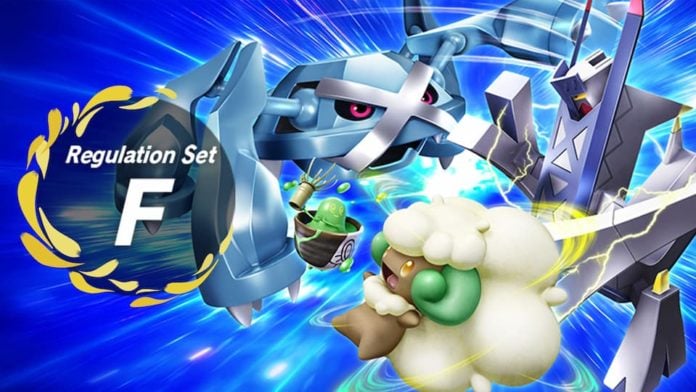
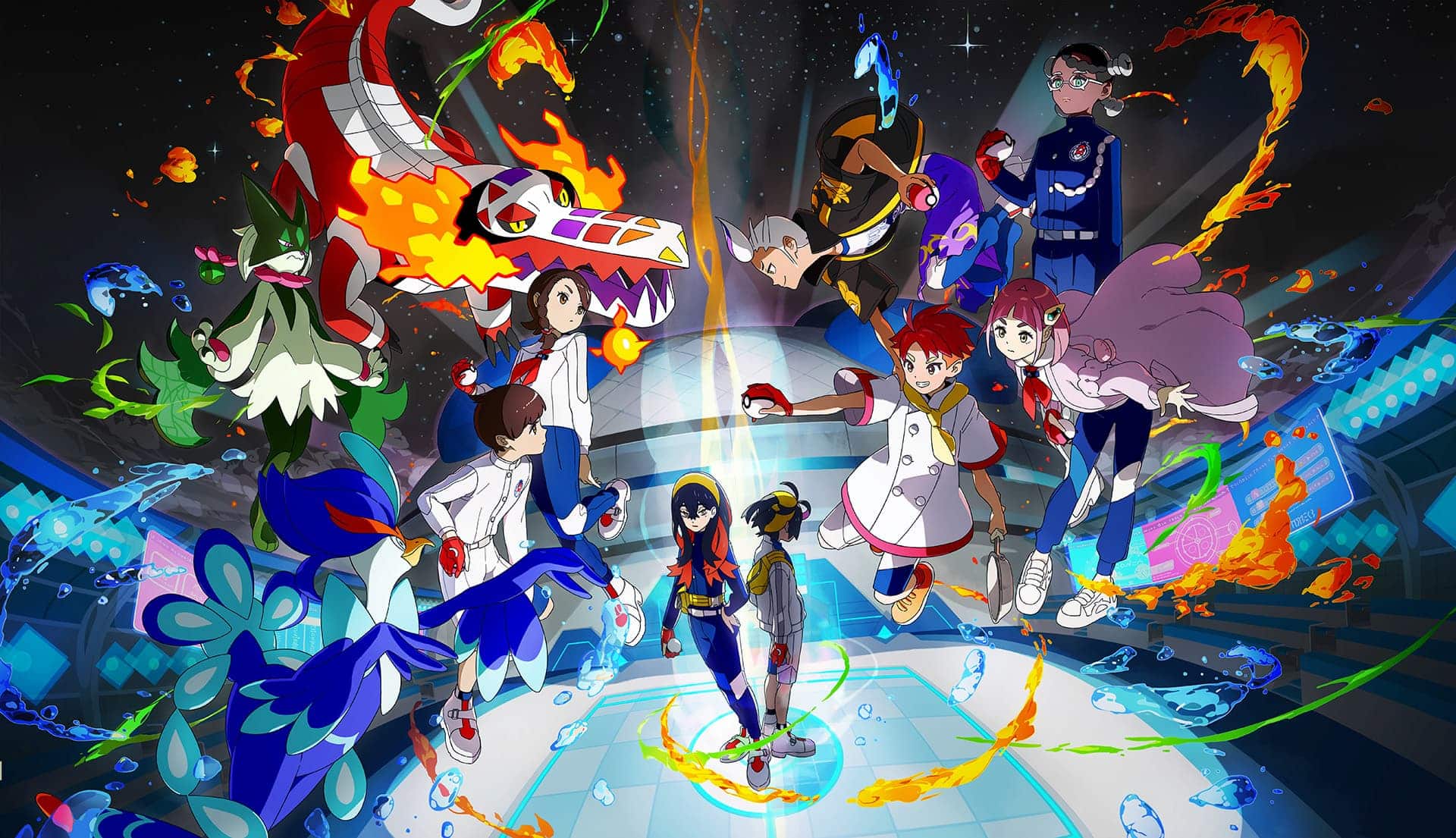
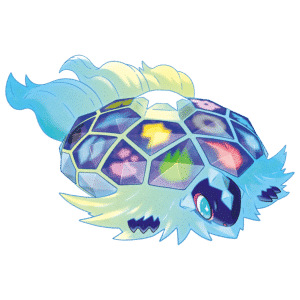
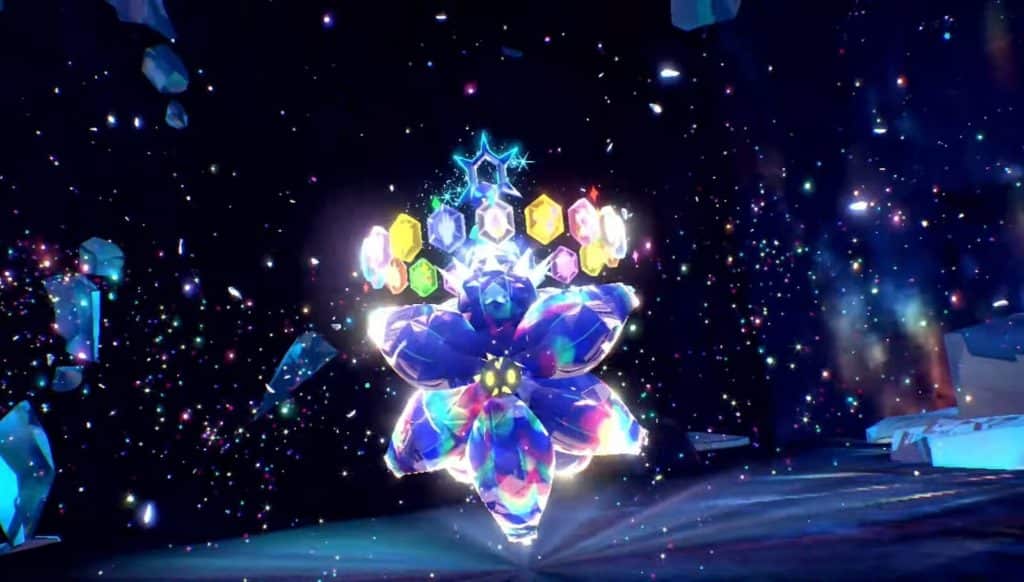
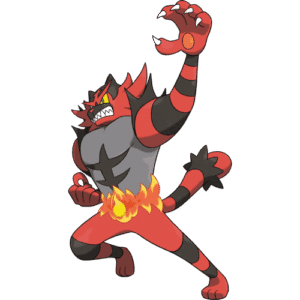
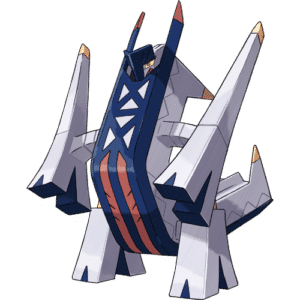
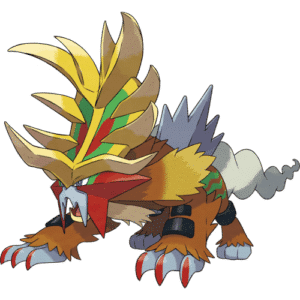
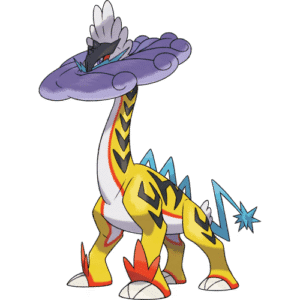
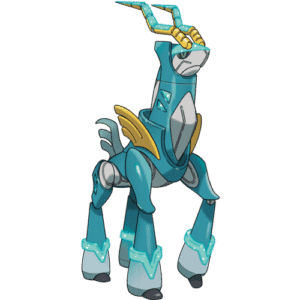
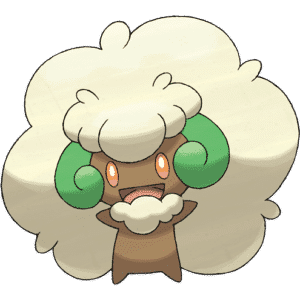
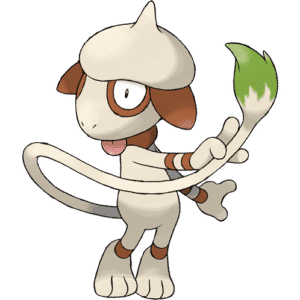
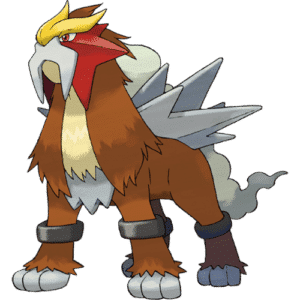
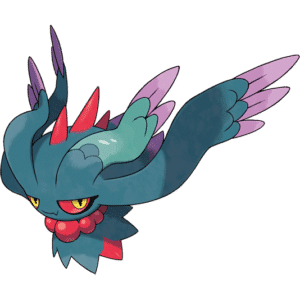

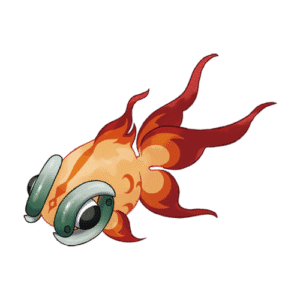
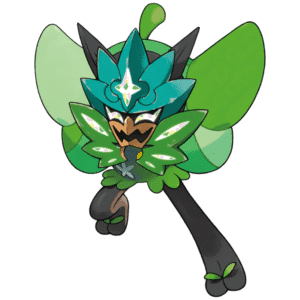
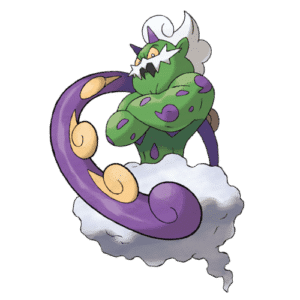
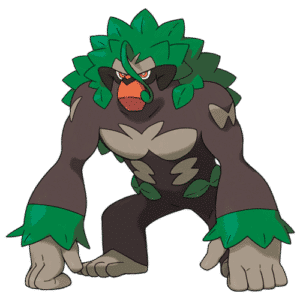

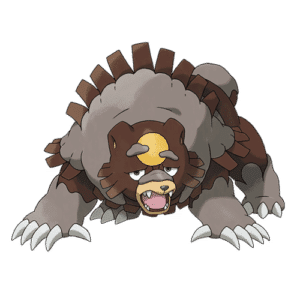
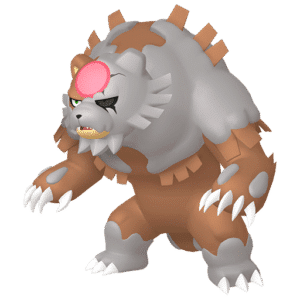 f
f